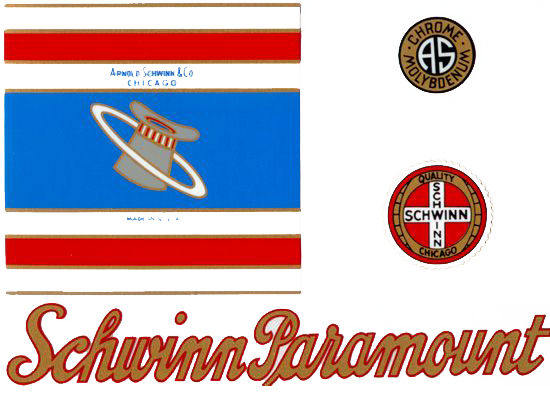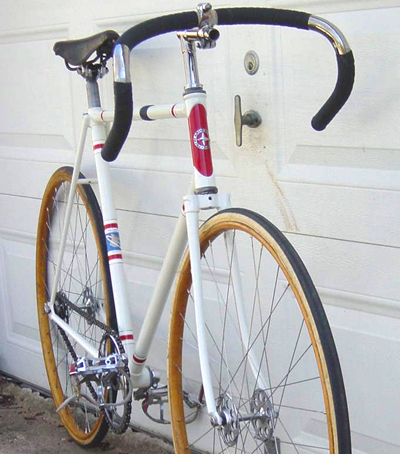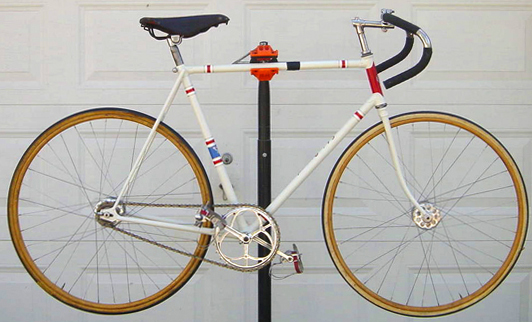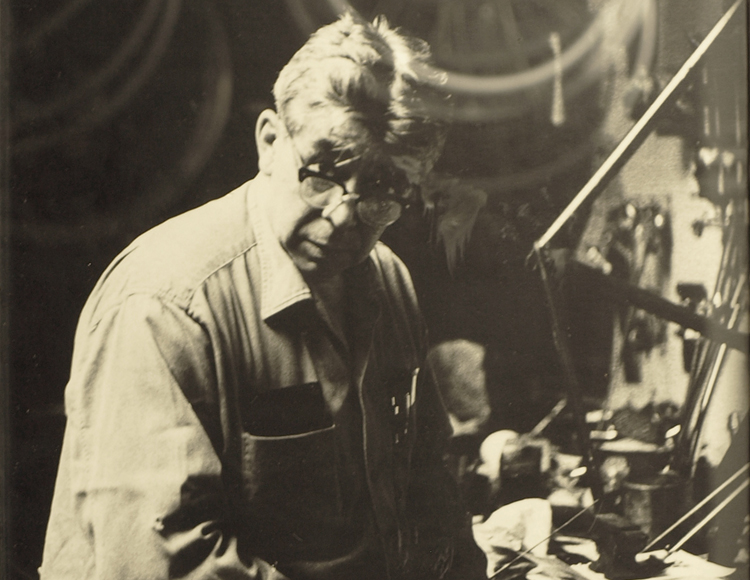Paramount – The Early Years
Paramount 1938-1958Arnold, Schwinn & Co. had participated in racing since its founding in the 1890’s. It had originally focused on building racing bicycles and had added recreational bikes as market demands grew. When Schwinn built its name on its mass-produced balloon-tire bicycles in the 1930s, many people lost the connection with its racing heritage even though Schwinn continued to sponsor bicycle racing. Frank W. Schwinn saw potential, both commercial and promotional, in offering an exclusive brand of hand-built race bicycles that he named Paramount. In 1938, Frank W. Schwinn officially introduced the Paramount. In its introductory catalog, Schwinn dedicated Paramount to the production of world competitive bicycles. High strength steel alloys were just becoming available as bicycle tubing and Paramounts from the outset were made with the new Chrome-Molybdenum formulas using brass lug-brazed construction. The lugs were carefully carved to improve strength and achieve a clean look. |
During 1930’s, Emil Wastyn had been building Schwinn’s race team bicycles. Schwinn stayed in the thick of the 6-day racing scene with rider such as Jerry Rodman.
Though the official introduction took place in 1938, the origins of the bike started earlier in the decade when Emil Wastyn became the framebuilder for Schwinn’s professional six-day racing team. Emil ran a bicycle store and frame shop not far from the Schwinn factory on Chicago’s West Side. Paramount-labeled bikes began to appear late in 1937, especially for Schwinn’s key six-day riders. In fact, the initial catalogs included letters from the current stars which promoted Emil Wastyn as much as Paramount.
During the next twenty years, most of the Paramounts would be built at Wastyn’s shop in spite of Schwinn’s efforts to bring frame production in-house. The earliest Paramounts followed Emil Wastyn’s signature styling (balled-end seat stays, for example) and keyhole-styled lugs. Over the years from 1939 to 1941, Paramounts evolved to have their own specific style – particularly the famous slant trimmed seat stays which remained in effect for 50 years. Emil built Paramounts from 1938 to 1941.
Schwinn also produced a variety of machined components to complement the frame – particularly a set of beautifully crafted wide-flange hubs. Schwinn also made parts such as stems, handlebars and even pedals, each marked with the famous Schwinn name in script.
Production halted during World War II. When Paramounts started back up after the war, Emil’s son Oscar Wastyn, known as Okky, built many of the Paramounts. Even before the war, Okky had been building frames called the Oscar Wastyn Special.
After the war, demand for racing bikes (as well as interest in racing) fell dramatically. Schwinn attempt to bring production back in-house, hiring a builder named Ovie Jensen. Ovie was a very capable builder but was devastated by the tragic death of his daughter. A freak accident victim, she died when her horse threw her off into the Des Plaines River. Ovie could no longer work unsupervised. Even then he had remained too despondent to be effective and he was eventually moved out of Paramount production altogether. Press here to see an example of Ovie’s work.
During the 50’s, Schwinn started feeling the influence of bike racer and engineer Frank Brilando. Beginning in 1952, a few of the Paramounts were built with the new Nervex lugs, Campagnolo dropouts and, of course, the new-style shifting system, the derailleur.
Frank Brilando had also promoted the use of silver as a brazing material instead of brass. It retained more of the basic strength of the tubing while reducing the need for cleanup. It also made the bikes more repairable.
During this period, Schwinn offered the following models (based on the ’56 catalog). Even through the ’56 catalog, the Paramounts were still advertised as having the keyhole lug design:
P11 – Tourist. This was the classic “English Racer”. It had keyhole lugs, Reynolds 531 tubing, plated chainguard, Paramount racing crank and hubs. A Sturmey-Archer three speed rear hub was also available as was the option of either a “matress” saddle or the venerable Brooks B-17. It came with extruded aluminum alloy rims and Schwinn Puff or Breeze (clincher) 26″ tires.
P12 – Racer (track bike). It came with full Paramount gear, alloy rims and tubular tires.
P-61 – Ladies model. This was the ladies version of the P11.
At one point Pete Gadron assembled Paramounts along with Joe Magnani in the so-called Continental room.
Paramount production had become a shambles by the later-1950’s. After Ovie’s departure, engineer George Flagle, built bikes for about six months. Then production moved back to Wastyn’s shop. Press here for an example of Oscar Wastyn’s work from the 1950’s.
Schwinn had made great strides in frame finishing during this period, decorating the Paramounts with the new metallic paints then becoming available. Joe Brilando, Frank’s brother, had developed extraordinary skills at the delicate art of pinstriping. Many of the Paramounts of the 50’s had intricate box striping in multiple colors.
But the Wastyns made it known that they were the real Paramount builders, and this stuck in many people’s craw at Schwinn. From Kieth’s view, something had to be done . . .



